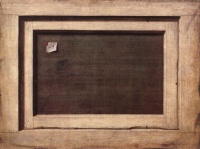Originality
From The Art and Popular Culture Encyclopedia
| Revision as of 11:23, 20 April 2014 Jahsonic (Talk | contribs) ← Previous diff |
Revision as of 11:37, 20 April 2014 Jahsonic (Talk | contribs) Next diff → |
||
| Line 14: | Line 14: | ||
| However, [[Umberto Eco]] in ''[[The Limits of Interpretation]]'' (1990) says that "much art has been and is [[repetitive]]. The concept of absolute [[originality]] is a contemporary one, born with [[Romanticism]]; classical art was in vast measure serial, and the "modern" [[avant-garde]] (at the beginning of [[20th century|this century]]) challenged the Romantic idea of "[[creation from nothingness]]," with its techniques of collage, mustachios on the Mona Lisa, art about art, and so on.[http://books.google.be/books?id=H4q8ZosSvB8C&pg=PA95&dq=%22The+concept+of+absolute+originality+is+a+contemporary+one,%22&hl=nl&sa=X&ei=vzsxU7nMFoOq7QbL5YGQBg&redir_esc=y#v=onepage&q=%22The%20concept%20of%20absolute%20originality%20is%20a%20contemporary%20one%2C%22&f=false] | However, [[Umberto Eco]] in ''[[The Limits of Interpretation]]'' (1990) says that "much art has been and is [[repetitive]]. The concept of absolute [[originality]] is a contemporary one, born with [[Romanticism]]; classical art was in vast measure serial, and the "modern" [[avant-garde]] (at the beginning of [[20th century|this century]]) challenged the Romantic idea of "[[creation from nothingness]]," with its techniques of collage, mustachios on the Mona Lisa, art about art, and so on.[http://books.google.be/books?id=H4q8ZosSvB8C&pg=PA95&dq=%22The+concept+of+absolute+originality+is+a+contemporary+one,%22&hl=nl&sa=X&ei=vzsxU7nMFoOq7QbL5YGQBg&redir_esc=y#v=onepage&q=%22The%20concept%20of%20absolute%20originality%20is%20a%20contemporary%20one%2C%22&f=false] | ||
| - | == Related == | + | == See also == |
| - | [[art]] - [[aura (Walter Benjamin)]] - [[authorship]] - [[authenticity]] - [[avant-garde]] - [[contemporary]] - [[copyright]] - [[creativity]] - [[difference]] - [[eccentric]] - [[experimental]] - [[individual]] - [[fame]] - [[genius]] - [[greatness]] - [[influence]] - [[modern]] - [[Modernism]] - [[outsider]] - [[proto-]] - [[source]] - [[technique]] - [[unique]] - [[unusual]] | + | *[[appropriation]] |
| - | + | *[[aura (Walter Benjamin)]] | |
| - | == Compare and contrast == | + | *[[authorship]] |
| - | + | *[[authenticity]] | |
| - | [[appropriation]] - [[category]] - [[derivative]] - [[copy]] - [[genre]] - [[formula]] - [[hybrid]] - [[mainstream]] - [[plagiarism]] | + | *[[avant-garde]] |
| + | *[[copy]] | ||
| + | *[[copyright]] | ||
| + | *[[creativity]] | ||
| + | *[[derivative]] | ||
| + | *[[eccentric]] | ||
| + | *[[experimental]] | ||
| + | *[[formula]] | ||
| + | *[[genre]] | ||
| + | *[[influence]] | ||
| + | *[[individual]] | ||
| + | *[[genius]] | ||
| + | *[[greatness]] | ||
| + | *[[plagiarism]] | ||
| == Theory == | == Theory == | ||
| Line 41: | Line 54: | ||
| *[[Original sin]] | *[[Original sin]] | ||
| [[Category:Non-mainstream]] | [[Category:Non-mainstream]] | ||
| + | *[[William Duff]]'s [[Essay on Original Genius]] (1767) | ||
| {{GFDL}} | {{GFDL}} | ||
Revision as of 11:37, 20 April 2014

.png)
|
Related e |
|
Featured: |
Originality is the aspect of created or invented works as being new or novel, and thus can be distinguished from reproductions, clones, forgeries, or derivative works. An original work is one not received from others nor one copied based on the work of others. The term "originality" is often applied as a compliment to the creativity of artists, writers, and thinkers.
The notion of originality came to prominence in the 18th century when Romanticism glorified creativity to the point of a veritable 'cult of originality,' which finds its origins in the famous 'Quarrel of the Ancients and the Moderns'.
However, Umberto Eco in The Limits of Interpretation (1990) says that "much art has been and is repetitive. The concept of absolute originality is a contemporary one, born with Romanticism; classical art was in vast measure serial, and the "modern" avant-garde (at the beginning of this century) challenged the Romantic idea of "creation from nothingness," with its techniques of collage, mustachios on the Mona Lisa, art about art, and so on.[1]
Contents |
See also
- appropriation
- aura (Walter Benjamin)
- authorship
- authenticity
- avant-garde
- copy
- copyright
- creativity
- derivative
- eccentric
- experimental
- formula
- genre
- influence
- individual
- genius
- greatness
- plagiarism
Theory
- Conjectures on Original Composition (1759), Edward Young
- Four words: Romantic, originality, creative, genius (1925) by Logan Pearsall Smith
- The Anxiety of Influence (1973), Harold Bloom
- The Originality of the Avant-Garde and Other Modernist Myths (1985), Rosalind E. Krauss
- Original Copy: Plagiarism and Originality in Nineteenth-Century Literature (2007) by Robert Macfarlane
Quotes
- The only way for us to become great lies in the imitation of the Greeks, a dictum by German art historian [[Johann Joachim Winckelmann
- "I'm devoted to the principle of originality." --John Cage
- "There is no great work of art which does not convey a new message to humanity -- Arnold Schoenberg
Threshold of originality
The threshold of originality is a concept in copyright law that is used to assess whether a particular work can be copyrighted. It is used to distinguish works that are sufficiently original to warrant copyright protection from those that are not. In this context, "originality" refers to "coming from someone as the originator/author" (insofar as it somehow reflects the author's personality), rather than "never having occurred or existed before" (which would amount to the protection of something new, as in patent protection).
See also
- Artistic inspiration
- Creativity
- Imitation
- Original sin
- William Duff's Essay on Original Genius (1767)



